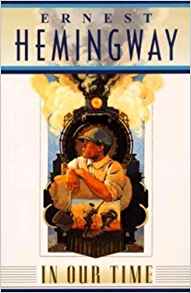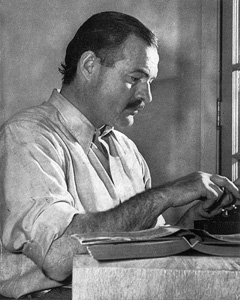
('Wandering River'© Stanley Zimny, 2012)
In this essay, shortlisted in the 2018 THRESHOLDS International Short Fiction Feature Writing Competition, Peter Jordan examines the influence of dyslexia and the paintings of Cezanne on the short stories of Ernest Hemingway.
~
Comments from the judging panel:
‘This is an interesting theory. The piece persuasively explains what Hemingway is doing – and offers fresh insights into his writing.’
‘Fittingly, given its subject, this essay packs a punch – impressing with its radical yet convincing analysis of Hemingway’s (in)famous writing style.’
‘An exciting and significant contribution to Disability Studies that clearly demonstrates how classic works of literature change with time.’
~
 Peter Jordan is a short story writer from Belfast. He has ADHD and dyslexia, and thinks in pictures. His writing has won numerous awards, and his debut short story collection, White Goods, will be released in May 2019 by KUP. He tweets at @PM_Jordan
Peter Jordan is a short story writer from Belfast. He has ADHD and dyslexia, and thinks in pictures. His writing has won numerous awards, and his debut short story collection, White Goods, will be released in May 2019 by KUP. He tweets at @PM_Jordan
~
HEMINGWAY’S SECRET
By PETER JORDAN
Reflecting on his early years in Paris, Ernest Hemingway wrote of a new literary technique he was in the process of inventing.
I was learning something from the painting of Cezanne that made writing true sentences far from enough to make the stories have the dimensions that I was trying to put into them. I was learning very much from him, but I was not articulate enough to explain it to anyone. Besides it was a secret.
(A Moveable Feast, 1964)
Is it possible that Hemingway was unable to articulate his secret affinity with Cezanne’s working methods because, as a manifestation of his dyslexia, its nature was a mystery. One of the conditions dyslexia conveys is visual thinking: the ability to think exclusively in detailed, three-dimensional images or moving pictures, rather than words. In his letter, Hemingway uses the word ‘dimensions’. It seems an unusual word to use when talking about writing. However, it is exactly the word a visual thinker would use. Hemingway would have had no way of articulating this. At that time, it was truly a secret, even to him.
The defining qualities of Hemingway’s minimalist writing — short sentences, short paragraphs, the short concrete word over its longer equivalent, mistrust of subordinate clauses, omission, and suggestion — here perfectly characterise dyslexic writing. And this is exactly what we see in the experimental writing contained in his first major collection, In Our Time (1925).
Although dyslexia can adversely affect reading and writing, it can also confer certain advantages. One of those advantages is the ability to think in clear, detailed images — with some people, moving images — not words. Most of us can think visually; if someone says ‘boat’ we may visualise the word boat and then the object itself. True visual thinkers think exclusively in images; they don’t see the letters or the word. They see a particular boat. They may even be able to board it and see inside it.
 Albert Einstein, another famous dyslexic, believed that words and numbers were not used in his primary mode of thought; his great breakthroughs came from visual experiments. He frequently described his thought process as being nonverbal and, in a letter to mathematician Jacques Hadamard in 1945, Einstein stated: ‘Words or language, as they are written or spoken, do not seem to play any role in my mechanism of thought.’
Albert Einstein, another famous dyslexic, believed that words and numbers were not used in his primary mode of thought; his great breakthroughs came from visual experiments. He frequently described his thought process as being nonverbal and, in a letter to mathematician Jacques Hadamard in 1945, Einstein stated: ‘Words or language, as they are written or spoken, do not seem to play any role in my mechanism of thought.’
At the age of sixteen, Einstein tried to imagine what it would be like to ride alongside a light beam. In his mind he pictured riding on one light wave, while looking at another light wave moving parallel to him. For the next ten years he wrestled with this thought experiment until, at the age of twenty-six, he came up with the Special Theory of Relativity.
When Hemingway first arrived in Paris in 1921, he was at a crucial stage of his writing career. He had trained as a journalist and had been mentored by Sherwood Anderson in America, but it was in Paris, as a protégé of Ezra Pound, that Hemingway really took off. In 1912-13, Pound had expounded a new theory on writing which he termed Imagism. Indeed, Pound’s Imagist principles could be viewed as a natural template for a writer with dyslexia who thinks in images. Consider Pound’s philosophy and how its tenets would have appealed to the young Hemingway, newly arrived in Paris:
1. to use the language of common speech, but to employ always the exact word
2. to create new rhythms
3. to allow absolute freedom in the choice of subject
4. to present an image
5. to produce poetry that is hard and clear, never blurred nor indefinite
6. finally, most of us believe that concentration is of the very essence of poetry.
Imagine a visual thinker being mentored by someone who had developed a theory that expressed their very way of thinking. Two of the techniques that Hemingway employs to such effect in his early work are Pound’s ‘Imagism’ and T.S. Eliot’s ‘objective correlative’. Eliot suggested a writer evoke a particular emotion using “a set of objects, a situation, a chain of events which shall be the formula of that particular emotion”. A simple example is a grey sky at a funeral. It stands to reason that a writer who thinks in terms of images or objects would be drawn to a literary device that employs their use with an emphasis on sensory experience.
In Hemingway’s correspondence with Gertrude Stein, there is a tantalising piece of evidence suggesting that he thought exactly this way. While in the process of inventing his new literary technique, he wrote her a letter dated 15th August, 1924 – he was twenty-five years old:
I have finished two long short stories, one of them not much good, and the other very good and finished the long one I worked on before I went to Spain where I’m trying to do the country like Cezanne and having a hell of a time and sometimes getting it a little bit. It is about 100 pages long and nothing happens and the country is swell, I made it all up, so I see it all and part of it comes out the way it ought to, it is swell about the fish…
If Hemingway thought in pictures instead of words, it would explain why he was trying to ‘do the country like Cezanne’. The story about the fish is ‘Big Two-Hearted River’, now considered a masterpiece. Hemingway was attempting to transfer that ability to think visually into words: ‘…so I see it all…’.
The story features Hemingway’s alter ego, Nick Adams, who goes on a solitary fishing trip after his return from the war. Although there is no explicit mention of what we now know as PTSD, Hemingway uses simple language and description of the countryside to suggest that all is not well with Nick; that there are problems he is trying to push aside; internal problems he is trying to get through by the simple actions of walking, camping and fishing. Hemingway suggests implicitly that there is something wrong. Consider the following short passage:
He felt a reaction against deep wading with the water deepening up under his armpits, to hook big trout in places impossible to land them. In the swamp the banks were bare, the big cedars came together overhead, the sun did not come through, except in patches; in the fast deep water, in the half light, the fishing would be tragic. In the swamp fishing was a tragic adventure. Nick did not want it. He didn’t want to go up the stream any further today.
 This passage imparts more than it should. It conveys the impression that there is something shocking underlying this seemingly simple story. The repetition of the word ‘tragic’ may be a bit heavy-handed and dated, but his connection of objects to sensation subtly reflects Pound’s Imagism and Eliot’s objective correlative. In Hemingway’s narrative, the clear descriptive prose springs from the image as the locus from where an emotion is conveyed to the reader; it is also the point at which his meaning converges with the reader’s interpretation of it. The reader interprets the text through the act experiencing the emotion. Hemingway’s story is one long narrative piece of objective correlative. His description of the countryside evokes an emotional response in the reader without the reader knowing why. Just as an observer’s experience of looking at a Cezanne evokes and emotional response to a created landscape.
This passage imparts more than it should. It conveys the impression that there is something shocking underlying this seemingly simple story. The repetition of the word ‘tragic’ may be a bit heavy-handed and dated, but his connection of objects to sensation subtly reflects Pound’s Imagism and Eliot’s objective correlative. In Hemingway’s narrative, the clear descriptive prose springs from the image as the locus from where an emotion is conveyed to the reader; it is also the point at which his meaning converges with the reader’s interpretation of it. The reader interprets the text through the act experiencing the emotion. Hemingway’s story is one long narrative piece of objective correlative. His description of the countryside evokes an emotional response in the reader without the reader knowing why. Just as an observer’s experience of looking at a Cezanne evokes and emotional response to a created landscape.
While writing the first part of ‘Big Two-Hearted River’ Hemingway visited the Musée du Luxembourg on a daily basis to view Cezanne’s work. He also studied the artist’s paintings in Stein’s salon. He may have unconsciously known what Cezanne was doing but putting that into words is where the problem lay, because of his dyslexia.
Stein would have fully understood a writer’s efforts to compose a story in which ‘nothing happens’, and this is where Hemingway excelled: evoking the required emotion within the reader without saying it ‘bang out’, as Katherine Mansfield put it. In his ABC of Reading, Pound states: ‘you use a word to throw a visual image on a reader’s imagination, or you charge it by sound or you use groups of words to do this…’
If visual thinking influenced Hemingway’s writing technique, then dyslexia influenced his writing style. In an essay titled, ‘A statistical analysis of the prose style of Ernest Hemingway: Big Two-Hearted River’, Elizabeth Wells notes:
… about 70 percent of the sentences are simple sentences — a childlike syntax without subordination — and repetition is often substituted for subordinate thoughts… it is the paratactic syntax most often found among children who have not yet learned to subordinate their ideas one after another without any relationships between them.
This statement would sound familiar to any dyslexia tutor, any parent of a dyslexic child or any adult with dyslexia. Subordinate clauses are unwieldy for a dyslexic writer. Instead, Hemingway uses repetition, something he picked up from Sherwood Anderson and Gertrude Stein. Repetition has the obvious effect of priming a reader, but it has other appeal: it helps sentences achieve fluency of rhythm and movement when there is a paucity of subordinate clauses; it links sentences that may otherwise appear as discrete units.
The trick is to write something quite ordinary that moves a reader unconsciously, i.e. indirectly. For the story to resonate, Nick’s internal trauma must remain implicit, yet still register with the reader. The more visceral the response, the more powerful the emotion experienced by the reader. Cezanne evoked such emotion in his paintings. His landscapes play with spatial dimensions, a strong foreground foreshadowing an indistinct background. There are direct parallels between the technique and style of Cezanne and that of Hemingway: discrete units and strong foregrounds with a less clear background. ‘Big Two-Hearted River’ adopts this pattern. On one level it is a simple fishing story; however, the reader is somehow moved by the arrangement of the words, the description of the landscape. The outer landscape is a metaphor for the inner feelings of the protagonist Nick:
Nick slipped off his pack and lay down in the shade. He lay on his back and looked up into the pine trees. His neck and back and the small of his back rested as he stretched. The earth felt good against his back. He looked up at the sky, through the branches, and then shut his eyes. He opened them and looked up again. There was a wind high up in the branches. He shut his eyes again and went to sleep.
Hemingway was able to turn what appeared to be a simple story, about a young man going on a lone fishing trip, into a voyage through the inner feelings of the character without once explaining those feelings. In ‘Big Two-Hearted River’ a young man is in mental turmoil, and the reader experiences that turmoil almost viscerally.
Many writers have tried, and failed, to copy Hemingway’s seemingly simple prose. But his style and technique came about through a uniquely perfect storm: the fusion of his dyslexia, his visual thinking, the influence of Ezra Pound, and the influence of the works of Cezanne.

